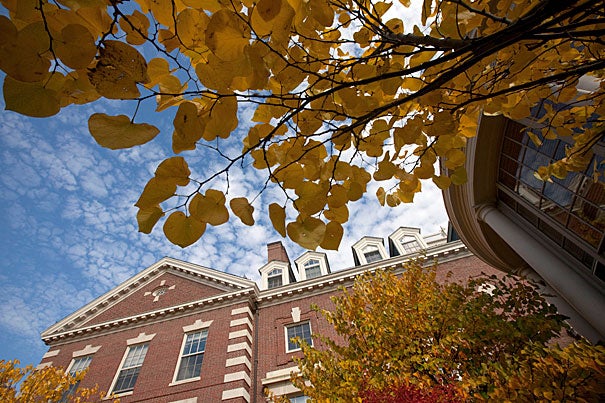
The results of the retirement program are detailed in the Office of Faculty Development and Diversity’s (FD&D) 2010 Annual Report, which highlights many of FD&D’s programmatic initiatives and presents up-to-date data on the composition of Harvard’s ladder faculty.
Kris Snibbe/Harvard Staff Photographer
46 faculty enter retirement program
Longer phased plans prove most popular choice
Forty-six faculty members have elected to take advantage of Harvard’s faculty retirement program, with longer phased retirement options the most popular choice.
The results of the program are detailed in the Office of Faculty Development and Diversity’s (FD&D) 2010 Annual Report released Monday (Nov. 15), which highlights many of FD&D’s programmatic initiatives and presents up-to-date data on the composition of Harvard’s ladder faculty. Of interest are the measurable changes in faculty composition that result directly from the University’s move to a tenure track system.
“We are happy to be able to support faculty renewal and provide an opportunity for long-serving faculty to make plans for the next stage of their career,” said Judith D. Singer, senior vice provost for FD&D. “At the same time, phased retirement helps us better anticipate future faculty needs. I see this as a win-win for everyone.”
Last December, five Harvard Schools announced a customized voluntary retirement program, including the Faculty of Arts and Sciences (FAS), the Harvard Medical School, the Harvard School of Public Health, the Harvard Divinity School, and the Harvard Graduate School of Education.
Eligibility was contingent on having at least 10 years of University service and being 65 or older on Sept. 1, 2010. Across the University, 176 faculty members were eligible for the program. Of the 127 eligible in FAS, 32 (25 percent) signed up; of the 49 eligible across the participating graduate and professional Schools, 14 (29 percent) signed up.
The programs were designed in response to interest from faculty members, and were crafted with the understanding that they seek in retirement to maintain relationships with their departments, their Schools, and the University, while exploring new opportunities for personal and intellectual renewal.
Each School designed its one-time program to meet the needs of its faculty members, some of whom were already contemplating the next stage of their careers. Older faculty members were the most likely to sign up, and the median age of participants was 70. In addition to the program, 10 more faculty members in these Schools had previously signed other retirement agreements, including nine in FAS.
More than half of the participants elected to take an option that offered two years of half-time teaching and service for full-time pay. Another third took an option that offered four years of half-time teaching and service for full-time pay in the first year and half-time pay in subsequent years, plus additional cash payments to help compensate for diminished retirement contributions. Less than 10 percent of participants took the option that offered retirement after a one-year paid sabbatical.
Because of the program’s success, the FAS, along with several of the professional Schools, is developing a new steady state faculty retirement program. Details of it, which will build on lessons learned in this program, will be announced later this year.
The retirement program results were just one component of the annual report, which highlights many of FD&D’s programmatic initiatives and presents up-to-date data on the composition of Harvard’s ladder faculty.
This year’s report also includes the first measurable changes in faculty composition that result directly from the University’s move to a tenure track system.
Harvard has 1,497 assistant, associate, and full professors, up 6 percent from seven years ago. This year, the University welcomed 64 new faculty: 44 assistant professors, 7 associate professors, and 13 full professors.
The entire increase in faculty size has been in the tenured ranks, which grew by 14 percent over the past seven years. During this period, the number of junior faculty has decreased slightly, a result of increased internal promotions and reduced junior hiring. University officials anticipate that the results of the recent retirement program will boost junior faculty hiring in the future.
The percentage of female faculty is at an all time high of 27 percent, up 56 individuals, or 16 percent, from seven years ago. As with the general faculty trends, the entire increase in the number of women has been in the tenured ranks, which grew by 34 percent during the same period. The University has also made modest gains in increasing the number of minority faculty. About 18 percent of the Harvard faculty are minorities, up 64 individuals, or 30 percent, from seven years ago.
In an effort to increase the pipeline of well-qualified students entering academia, FD&D helps to inform, motivate, and prepare undergraduates, graduate students, and postdoctoral fellows interested in pursuing academic careers. In addition to its flagship Summer Research Opportunities at Harvard program, last summer FD&D began working with 17 undergraduate research programs across the University, serving more than 300 students, to provide a more standardized and supported experience.




